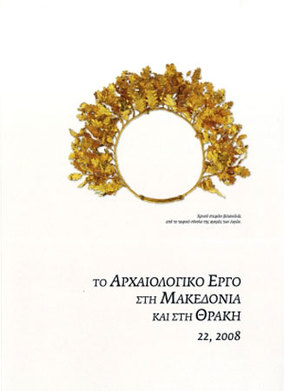Νεότερα στοιχεία από το ανατολικό νεκροταφείο της Αμφίπολης στα πλαίσια του έργου «Διαπλάτυνση του δρόμου Αμφίπολης - Μεσολακκιάς»
Part of : Το Αρχαιολογικό Έργο στη Μακεδονία και στη Θράκη ; Vol.14, No.1, 2000, pages 55-70
Issue:
Pages:
55-70
Parallel Title:
New data from the east cemetery of Amphipolis, owing to the widening of the Amphipolis-Messolakkia road
Author:
Abstract:
In 1999 and 2000, the 18th Directorate of Prehistoric and Classical Antiquities conducted an extensive rescue excavation in the E cemetery of Amphi- polis, in view of the proposed widening of the Amphipolis-Messolakkia road. The main cemetery of ancient Amphipolis lies NE and, mainly, E of the ancient city. The excavations conducted between 1956 and 1998 uncovered about 700 graves. Investigations in 1999-2000 in an area of about 1.4 ha uncovered a further 660 or so. Trenches A and Γ yielded parts of a wall and clay water pipes, which probably belong to the aqueduct of ancient Amphipolis. In trench Γ, the walls of numerous cist-graves were painted inside with vegetal and linear decoration in various hues. Part of a Π-shaped enceinte 60 m long and oriented N-S was found in trenches B, Δ, and E. The earliest phase dates to the Classical period and consists of dressed blocks of poros, while the latest phase, which dates to the Hellenistic period, consists of rubble stones. Numerous grave stelai were found as spolia in the masonry of the enceinte. Graves of horses were found within and outside the enceinte. Another surprise was the discovery of a large Macedonian tomb with a dromos, antechamber, and main chamber. The floor of the tomb was decorated with coloured mortar. The graves in trench ΣΤ are less densely clustered than in trenches B, A, and E, but they are meticulously constructed and lavishly provided with burial offerings.There is no single clear orientation in the E cemetery of Amphipolis, though a majority of the graves are oriented E-W. All the known types of graves of the Late Classical, Hellenistic, and Roman periods are found here. They are lavishly furnished with burial offerings and yielded a large number of vessels, figurines, coins, and gold and silver jewellery.The available data indicate that the cemetery began to be used in the 2nd half of the 5th century BC and continued without interruption into the 1st century AD.
Subject:
Subject (LC):
Keywords:
Σέρρες
Notes:
Περιέχει εικόνες και σχέδια ανασκαφής




